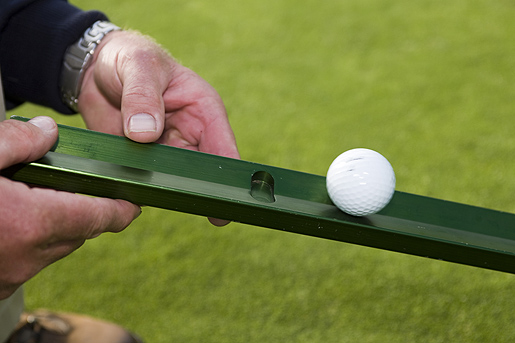The Stimpmeter
by Andrew Boyd
Today, low tech in a high tech game. The University of Houston's College of Engineering presents this series about the machines that make our civilization run, and the people whose ingenuity created them.
I find it funny that a game born in animal pastures now lays claim to some of the most sophisticated technology in sport. That game is golf. And while I could point to playing equipment — balls, clubs, apparel — many other sports have experienced similar advances. Where golf's different, and it's changed the entire game, is in the construction and care of golf courses. And nowhere is the technology more fully on display than on the putting green.
The ideal green has no blemishes. The more a ball "rolls true" the more the game relies on skill rather than chance. As a result, the pursuit of ever more perfect greens borders on maniacal. Special mowers are capable of cutting grass to a tenth of an inch. Heavy rolling machines smooth the surface. And this is to say nothing of the sand, dirt, and grass capable of surviving such preening.

But for all of the putting green innovations the best known is the simplest of all. At the 1935 U.S. Open, amateur golfer Edward Stimpson saw a problem. On some greens the ball rolled much faster than on others. That left players guessing. How could the greens be made more consistent from hole to hole?
Stimpson started by asking how to determine the speed of a green. The answer was to measure how far a ball would roll when imparted with a fixed amount of energy. His solution? A thirty-six inch stick with a v-groove running its length. One can almost imagine an early prototype cobbled together from wooden yardsticks. On a flat section of the green place the ball on one end of the stick. Raise that end about twelve-and-a-half inches above the ground. Let the ball roll down and onto the green. Finally, measure how far it goes. If the ball rolls ten feet, we say the green is "a ten on the Stimpmeter."

A low number indicates a slow green; a high number a fast green. Mistakes are magnified on a fast green. On a slow green, if I strike a ball a little too hard, it may roll a foot past the hole. On a fast green, that same miss-hit could translate to a much longer distance. Contours are also more difficult to navigate on a fast green. Green speed is to golfers what Kate Middleton's attire is to monarch mavens.
Not surprisingly, the speed of greens has been going up. When greens were measured in 1977 at the Masters Tournament, they averaged 7.9 on the Stimpmeter. Today, speeds are approaching twice that.
It's all thanks to technology. And it's fair to ask: is all that technology being put to its best use? That's a question the game's governing bodies have been asking themselves with renewed urgency in recent years. It's a question of what's best for the game and what's best for the planet. But I'm sure whatever happens we'll long see tournament officials wandering courses in the wee hours, trusty Stimpmeters in hand.
I'm Andy Boyd at the University of Houston, where we're interested in the way inventive minds work.
(Theme music)
Stimpmeters are ingeniously designed. In order for tests using the Stimpmeter to be uniform, the angle formed with the ground must be identical for each roll. Rather than using a vertical brace, which would make the device more cumbersome, a notch is placed 30 inches from the lower end (see pictures). By precisely engineering the notch, the ball will release when the Stimpmeter is tilted to the appropriate angle of about 20 degrees. The Stimpmeter is truly nothing more than a stick with a hole in it.
R. Hurley. The Obsession with Putting Green Speed and Misuse of the Stimpmeter. From the website: http://bentgrassdoctor.com/putting_green_speed_and_the_stimpmeter. Accessed March 26, 2013.
B. Klein. "Augusta's Greens: Secrets to Magic Carpet Ride." Golf Week. April 5, 2012. See also the Golf Week website: http://golfweek.com/news/2012/apr/05/augustas-greens-secrets-magic-carpet-ride/. Accessed March 26, 2013.
H. Yun. USGA Introduces Updated Stimpmeter. January 25, 2013.
The picture of the green roller is from a website of the AgriMetal Company. The pictures of the Stimpmeter are from a website of the United States Golf Association.
This episode first aired on March 28, 2013.
